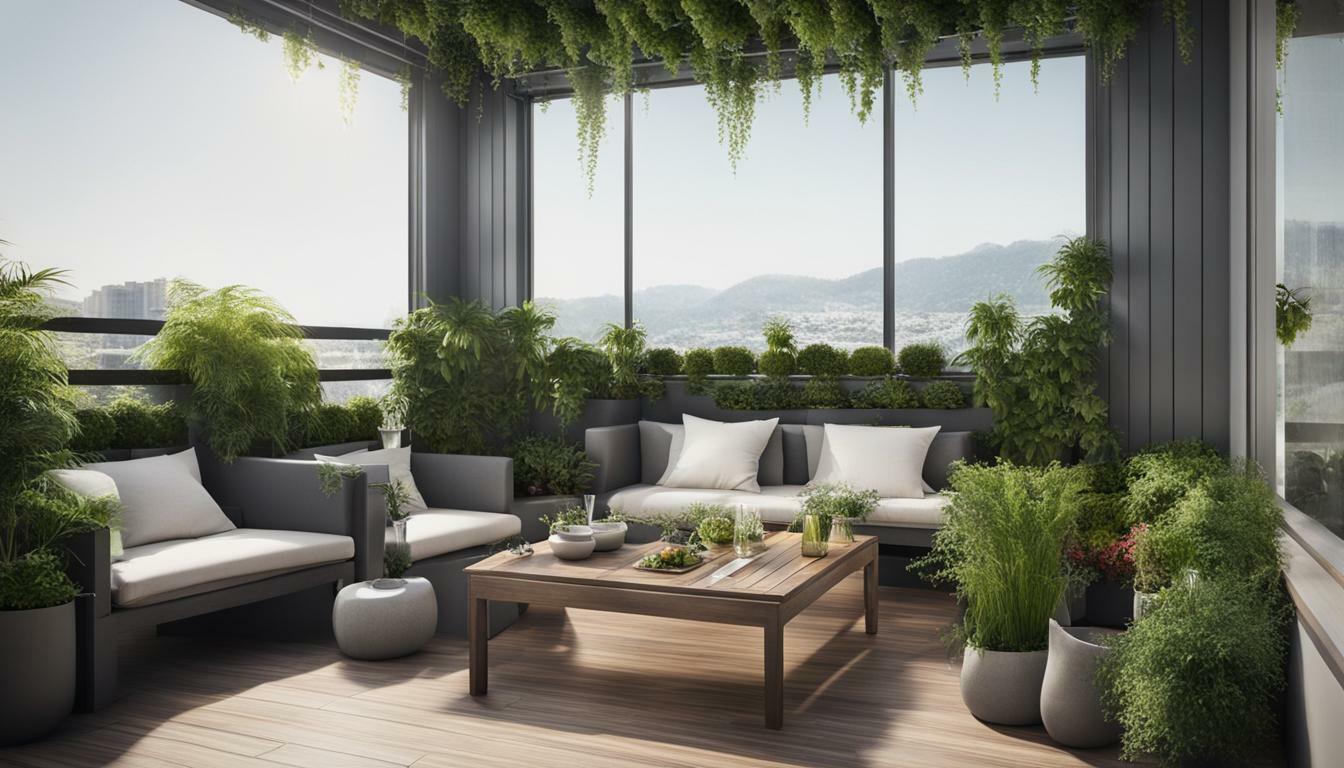Transform your balcony into a lush, green paradise with a vertical balcony vegetable garden. In today’s urban living, where space is limited, creating a vertical garden on your balcony is a smart way to maximize the available area and still enjoy the benefits of gardening. With the right design and selection of plants, you can grow an abundance of vegetables and herbs, even in a small space.
Key Takeaways:
- Create a vertical balcony vegetable garden to maximize space in small urban areas.
- Choose shade-tolerant plants for covered balconies or use grow lights to provide sufficient sunlight.
- Consider the watering method that suits your balcony setup, whether it’s a hose, watering can, or hydroponics system.
- Ensure the soil is well-draining and use containers with holes for proper water drainage.
- Water your plants deeply and less often to promote healthy growth.
Benefits of Vertical Balcony Gardening
Growing vegetables on a balcony offers numerous benefits, including the ability to maximize limited space and create a beautifully designed garden. With a vertical balcony garden, you can make the most of your small urban area and enjoy the satisfaction of growing your own fresh produce. Here are some key advantages of vertical balcony gardening:
- Space Optimization: Vertical gardening allows you to make use of vertical space that would otherwise go unused. By utilizing vertical structures such as trellises, hanging shoe organizers, and planters, you can grow a wide variety of vegetables even in a small space.
- Enhanced Design: A vertical balcony garden adds visual interest and beauty to your outdoor space. You can design your garden to be both functional and aesthetically pleasing by arranging plants in a creative and organized manner.
- Accessibility: With a vertical garden, you can easily access and care for your plants without the need to bend down or kneel. This makes gardening more accessible for people of all ages and abilities.
- Increased Yield: Vertical gardening allows plants to grow upwards, maximizing sunlight exposure and air circulation. This can result in higher yields compared to traditional gardening methods, as well as healthier and more productive plants.
- Environmental Benefits: Growing your own vegetables on a balcony helps reduce the carbon footprint associated with transporting produce. It also promotes biodiversity by providing habitats for birds, bees, and beneficial insects.
With these benefits in mind, it’s clear that vertical balcony gardening is a practical and rewarding way to create a thriving garden in a small space.
| Advantages | Description |
|---|---|
| Space Optimization | Utilize vertical structures to maximize small space |
| Enhanced Design | Create a visually appealing and organized garden |
| Accessibility | Easily care for plants without bending or kneeling |
| Increased Yield | Maximize sunlight exposure and air circulation for higher yields |
| Environmental Benefits | Reduce carbon footprint and promote biodiversity |
“Vertical gardening allows you to make the most of limited space, creating a beautiful and productive garden right on your balcony.” – Expert Gardener
Expert Tip: Choosing the Right Vegetables
When planning your vertical balcony garden, it’s important to choose the right vegetables that will thrive in limited space. Opt for compact and bushy varieties, such as cherry tomatoes, peppers, lettuce, herbs, and dwarf varieties of beans and cucumbers. Additionally, consider the amount of sunlight your balcony receives and choose vegetables that are appropriate for the light conditions. This thoughtful selection will help ensure the success of your vertical balcony garden.
Image:
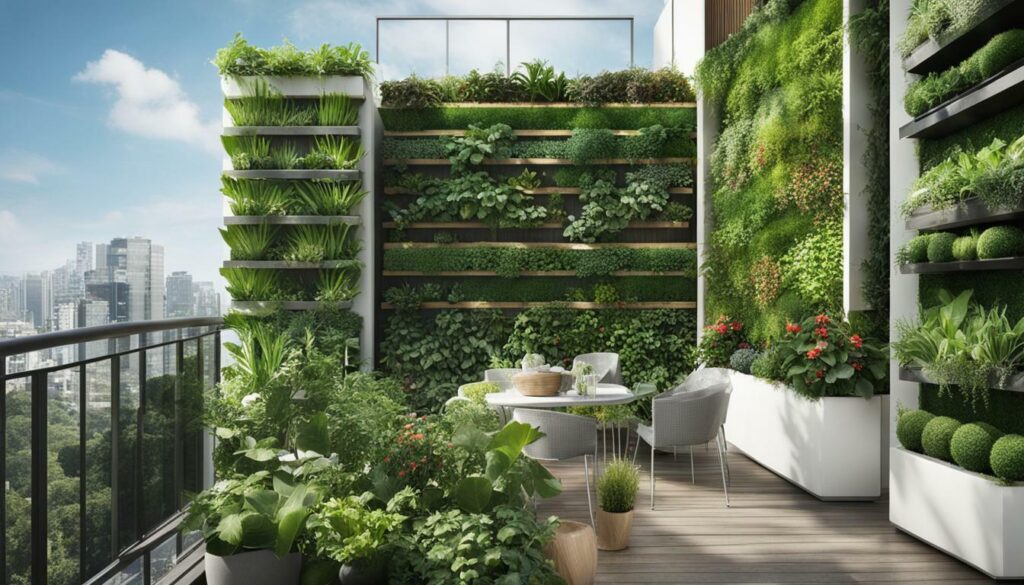
Choosing the Right Plants for Vertical Gardening
When planning your vertical balcony garden, it’s important to choose the right plants that are suitable for vertical gardening and balcony conditions. By selecting plants that thrive in limited space and can grow vertically, you can maximize your balcony’s potential and create a beautiful and productive garden. Whether you’re interested in growing vegetables, herbs, or flowers, there are a variety of plants that are well-suited for vertical gardening.
Here are some tips to help you choose the right plants for your vertical balcony garden:
- Consider sunlight exposure: Assess the amount of sunlight your balcony receives throughout the day. Some plants require full sun, while others can tolerate partial shade. Choose plants that match the sunlight conditions of your balcony to ensure their growth and development.
- Choose compact and dwarf varieties: Look for plants that have a compact growth habit or are specifically bred to be smaller in size. These plants take up less space and are ideal for vertical gardening.
- Opt for climbers and vining plants: Climbing plants and vining vegetables are perfect for vertical gardening. They can be trained to grow upwards, taking advantage of trellises, fences, or other vertical structures.
- Select plants with shallow root systems: As space is limited in a vertical garden, choose plants that have shallow root systems. This allows them to thrive in containers or wall-mounted planters.
Here is a table highlighting some popular plants for vertical gardening:
| Plant | Light Requirements | Growth Habit | Container Size |
|---|---|---|---|
| Tomatoes | Full sun | Indeterminate | Large container or hanging basket |
| Herbs (such as basil, mint, and parsley) | Full sun to partial shade | Compact | Small to medium-sized container |
| Lettuce and salad greens | Partial shade | Compact | Small container or vertical planter |
| Cucumbers | Full sun | Vining | Trellis or vertical support system |
| Flowering vines (such as morning glory or sweet pea) | Full sun to partial shade | Climbing | Trellis or vertical structure |
Remember to choose plants that suit your personal preferences, balcony conditions, and gardening goals. Experiment with different combinations and varieties to create a vertical garden that is both visually appealing and productive.
DIY Vertical Vegetable Garden Ideas
Get inspired with these creative DIY vertical vegetable garden ideas that will help you make the most of your balcony space. Whether you have a small apartment balcony or a spacious outdoor patio, these ideas will maximize your gardening potential in a vertical manner.
Plastic Gutter Vertical Vegetable Garden
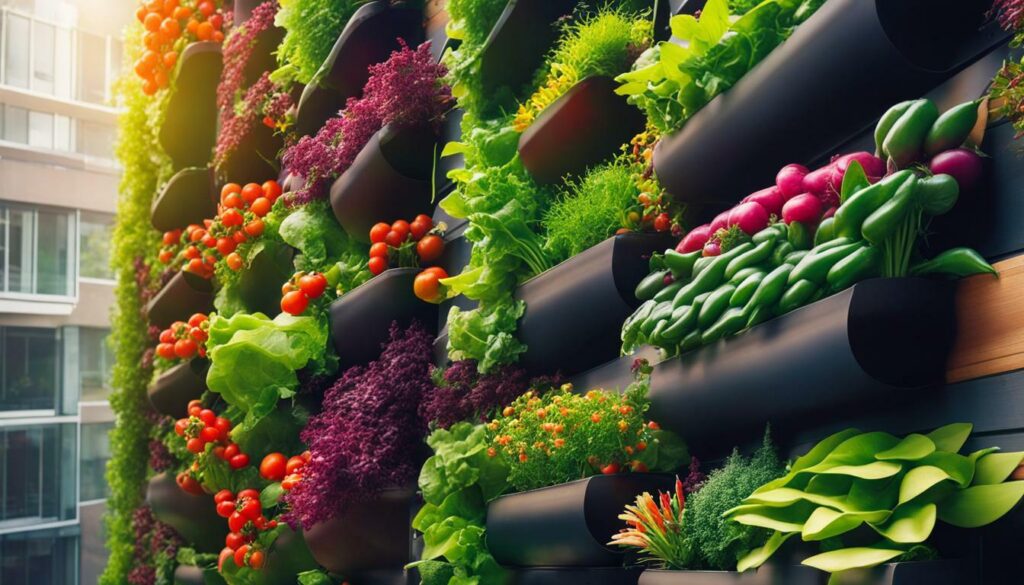
One clever DIY idea is to use plastic gutters as vertical planters. Simply attach the gutters to the wall or railing of your balcony and fill them with soil to plant your favorite vegetables. This space-saving solution allows you to grow a variety of edibles without taking up valuable floor space. Check out the tutorial in Spanish (translate it if needed) and get started on this project.
Growing Herbs and Vegetables in Hanging Shoe Organizer
Another fantastic idea is to use a hanging shoe organizer to grow herbs and leafy greens. Hang the organizer on the wall or railing of your balcony and fill each pocket with soil. Plant your desired herbs or vegetables in each pocket and watch them thrive in this compact vertical garden. It’s a great way to utilize vertical space and create a beautiful balcony garden!
Vertical Green Planter
For an endless supply of green onions, create a vertical green planter using a large plastic bottle and a pot. Cut the bottle into a vertical section, leaving the top open as a planter. Fill the bottle with soil and plant green onions in the holes, allowing them to grow upward. This DIY project is a creative and space-saving way to grow your own fresh herbs.
Hydroponic Vertical Tomatoes Gardening
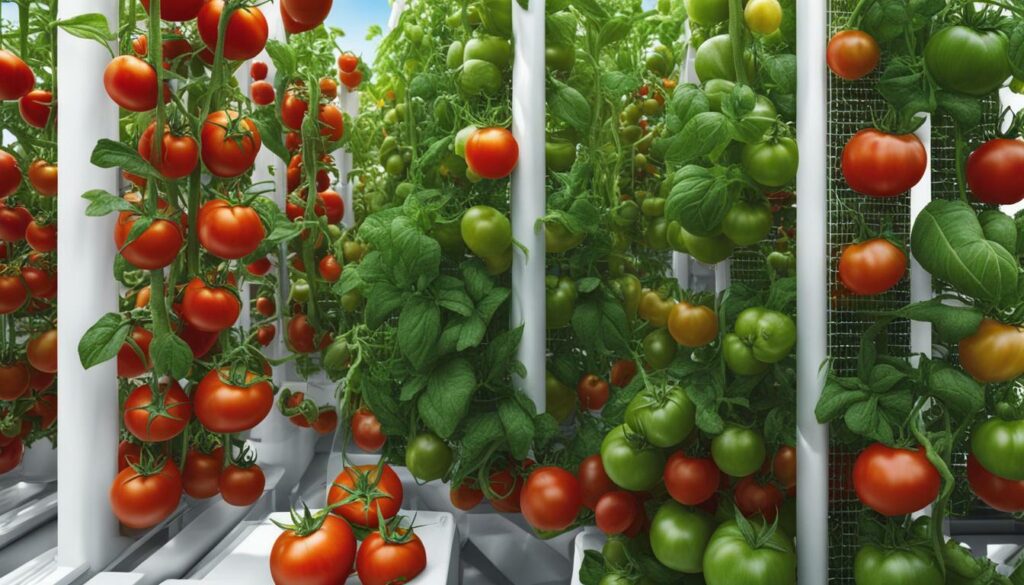
If you’re interested in hydroponics, consider growing tomatoes vertically in hydroponic towers. These towers allow you to grow a large number of tomatoes in a limited space, making it ideal for balcony gardening. Find a detailed plan and step-by-step instructions to set up your hydroponic vertical tomato garden.
These DIY vertical vegetable garden ideas offer creative and practical solutions for maximizing space on your balcony. Whether you choose to use plastic gutters, hanging shoe organizers, or vertical green planters, you can create a thriving vegetable garden in a small vertical space. Experiment with different ideas and techniques to find the best options for your balcony garden.
Hydroponic and Container Gardening for Vertical Spaces
Hydroponic and container gardening are excellent options for vertical spaces, allowing you to grow a wide variety of vegetables in a compact and efficient manner. These methods are particularly advantageous for balcony gardens, where limited space necessitates creative solutions for maximizing plant growth.
Hydroponic Gardening: In hydroponic gardening, plants are grown without soil, using nutrient-rich water as the growing medium. This technique offers several benefits, including faster growth rates, higher yields, and reduced water usage compared to traditional soil-based gardening. Hydroponic systems can be easily adapted to vertical spaces, such as hanging shelves or towers, allowing you to grow a variety of vegetables in a small footprint.
Container Gardening: Container gardening involves growing plants in pots or containers filled with soil or growing medium. This method is versatile and well-suited for vertical gardening on balconies. Container gardens can be arranged in vertical tiers, utilizing hanging pots or stacking planters, to make the most of limited space. It is essential to choose containers that have adequate drainage and are large enough to accommodate the root systems of the plants.
Benefits of Hydroponic and Container Gardening for Vertical Spaces
1. Space Optimization: Hydroponic and container gardening allow you to utilize vertical space effectively. By growing plants vertically, you can make use of unused wall space, balconies, or railings, doubling or even tripling your growing area compared to traditional gardening methods.
2. Greater Control: With hydroponic and container gardening, you have more control over the growing conditions. You can customize the nutrient levels, pH balance, and water supply to meet the specific needs of your plants. This control leads to healthier and more productive plants.
3. Reduced Maintenance: Vertical gardening with hydroponic and container systems requires less maintenance compared to traditional gardening methods. The controlled environment minimizes weed growth and pest infestations, reducing the need for herbicides and pesticides. Additionally, the compact nature of vertical gardens makes watering and fertilizing more efficient and less time-consuming.
| Vegetables Suitable for Hydroponic Gardening | Vegetables Suitable for Container Gardening |
|---|---|
| Lettuce | Tomatoes |
| Spinach | Peppers |
| Kale | Herbs |
| Swiss Chard | Cucumbers |
| Strawberries | Beans |
“Hydroponic and container gardening offer a convenient and space-saving solution for growing vegetables in vertical spaces. With careful planning and the right techniques, you can create a flourishing garden on your balcony, providing you with fresh produce right at your doorstep.”
Tips for Successful Vertical Gardening
To ensure the success of your vertical balcony garden, it’s important to follow these expert tips and techniques for small space gardening. With limited space, maximizing efficiency and using the right methods can help you create a thriving garden that not only beautifies your balcony but also provides you with fresh produce.
1. Choose the Right Plants
When it comes to vertical gardening, selecting the right plants is crucial. Consider the amount of sunlight your balcony receives and choose plants that thrive in those conditions. Some shade-tolerant options include lettuce, Swiss chard, and herbs like cilantro and parsley. For sun-loving plants, such as tomatoes and peppers, ensure they receive adequate sunlight by placing them on the edge of your balcony or using grow lights.
| Shade-tolerant Plants | Sun-loving Plants |
|---|---|
| Lettuce | Tomatoes |
| Swiss chard | Peppers |
| Cilantro | |
| Parsley |
2. Use the Right Soil
Proper soil is essential for healthy plant growth. Use a well-draining soil mix that retains moisture without becoming waterlogged. You can create a custom soil mix by combining potting soil, compost, and perlite or vermiculite for better drainage. Ensure your containers have drainage holes to prevent waterlogging and root rot.
3. Provide Adequate Watering
Watering plays a vital role in the success of your vertical balcony garden. Since vertical gardens can dry out quickly, it’s important to water them regularly. Check the moisture level of the soil by sticking your finger about an inch deep. If it feels dry, it’s time to water. Use a watering can or hose with a gentle spray to avoid damaging the plants. Consider installing a drip irrigation system for more efficient watering.
Remember, overwatering can be just as harmful as underwatering. Avoid waterlogged soil by ensuring proper drainage and allowing the soil to dry out slightly between waterings.
4. Maintain Plant Care
Regular maintenance is key to a successful vertical balcony garden. Monitor your plants for signs of pests or diseases and take immediate action to prevent further damage. Prune and trim your plants as needed to encourage healthy growth and remove any dead or yellowing leaves. Apply organic fertilizers regularly to provide essential nutrients for optimal plant growth. Additionally, consider rotating your plants to ensure balanced sunlight exposure and avoid nutrient depletion.
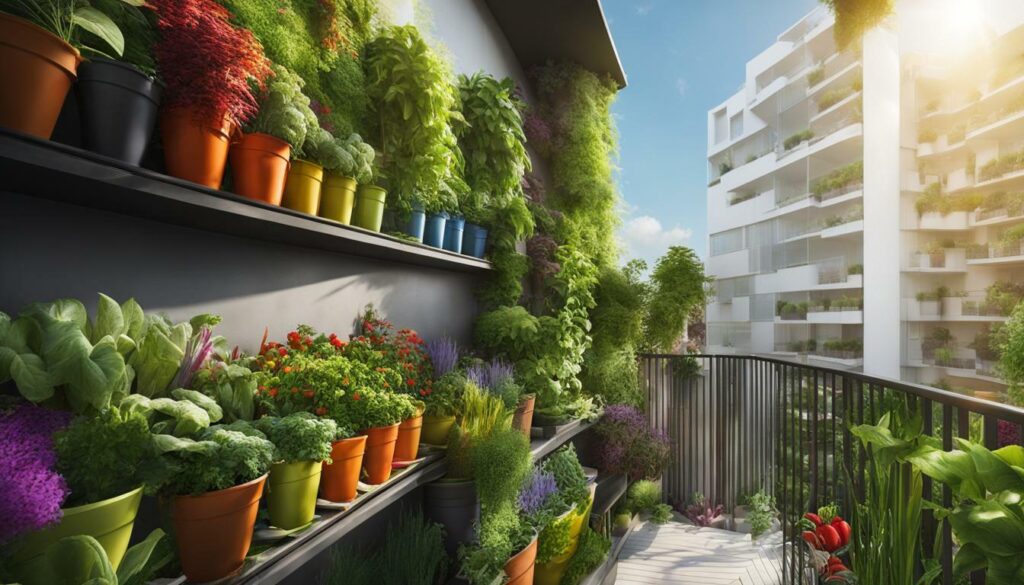
By following these expert tips and techniques for small space gardening, you can create a thriving vertical balcony garden. Enjoy the satisfaction of growing your own fresh produce and the beauty of a green oasis in your limited outdoor space.
Creative Ways to Maximize Space in a Vertical Balcony Garden
Discover innovative ideas and techniques to maximize space in your vertical balcony garden, allowing you to grow a variety of vegetables and herbs in a small area. Whether you have a small balcony or limited outdoor space, these creative solutions will help you make the most of your vertical garden.
One popular idea is to use plastic gutters as vertical planters. By attaching gutters to your balcony railing or wall, you can create a tiered garden that maximizes space. Fill the gutters with potting soil and plant your favorite vegetables or herbs. This method is ideal for growing smaller plants that don’t require a lot of space.
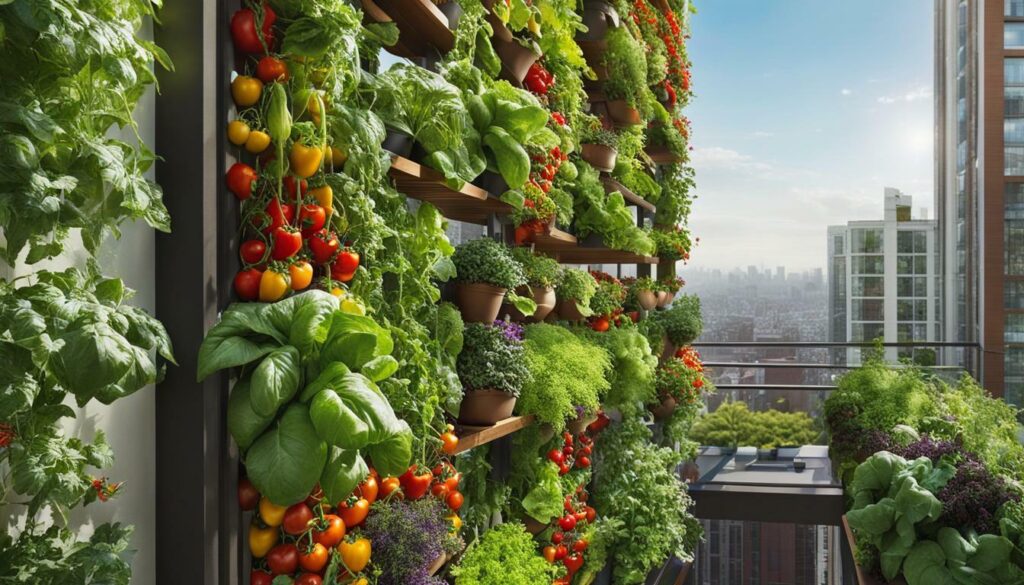
Another creative option is to repurpose a hanging shoe organizer as a vertical garden. Simply fill the pockets with soil and plant your desired herbs or leafy greens. This method is perfect for small spaces and allows you to easily access your plants for watering and harvesting.
Vertical Balcony Garden Ideas
- Plastic Gutter Vertical Vegetable Garden
- Growing Herbs and Vegetables in Hanging Shoe Organizer
- Vertical Green Planter
If you’re looking for a more DIY approach, consider using vertical green planters. These planters allow you to grow a variety of plants in stacked layers, making efficient use of vertical space. You can easily build your own vertical green planter using a large plastic bottle, a pot, and a few other supplies.
Additionally, hydroponic gardening is a great option for vertical spaces. This method allows you to grow plants without soil by using nutrient-rich water solutions. Hydroponic towers are ideal for growing tomatoes vertically and can be a space-saving solution for balconies.
By utilizing these creative ideas and techniques, you can transform your vertical balcony garden into a productive and beautiful space. Experiment with different methods and plant varieties to find what works best for you and enjoy the benefits of growing your own fresh vegetables and herbs in a small area.
| Vertical Balcony Garden Ideas | Materials | Benefits |
|---|---|---|
| Plastic Gutter Vertical Vegetable Garden | Plastic gutters, potting soil, plants | Maximizes space, easy to maintain |
| Growing Herbs and Vegetables in Hanging Shoe Organizer | Hanging shoe organizer, soil, herbs or leafy greens | Perfect for small spaces, accessible |
| Vertical Green Planter | Large plastic bottle, pot, other supplies | DIY approach, efficient use of vertical space |
| Hydroponic Vertical Tomatoes Gardening | Hydroponic towers, nutrient-rich water solution, tomatoes | No soil required, space-saving |
Maintaining and Caring for a Vertical Balcony Garden
Proper maintenance and care are essential for the health and productivity of your vertical balcony garden. Follow these tips to ensure your plants thrive.
Watering
Watering is crucial for the success of your vertical balcony garden. It’s important to provide your plants with the right amount of water, neither too much nor too little. Overwatering can lead to root rot and other issues, while underwatering can cause plants to wilt and die.
Keep a close eye on the moisture level of the soil and water your plants accordingly. Depending on the weather conditions and the type of plants you’re growing, you may need to water them daily or every few days. It’s best to water in the early morning or late afternoon to avoid evaporation and ensure that the plants have enough time to dry before the cooler evening temperatures.
Consider using a drip irrigation system or self-watering containers to make watering easier and more efficient. These systems provide a consistent and controlled water supply to your plants, reducing the risk of overwatering or underwatering.
Fertilizing
Fertilizing is essential to provide your plants with the nutrients they need to grow and produce healthy fruits and vegetables. Choose a balanced fertilizer that is suitable for the specific needs of the plants you’re growing in your vertical balcony garden.
Follow the instructions on the fertilizer packaging for the correct dosage and frequency of application. It’s best to fertilize your plants during their active growing season, usually in the spring and summer months. Be careful not to overfertilize, as this can damage the plants.
Consider using organic fertilizers, such as compost or worm castings, to nourish your plants naturally and promote overall soil health. Organic fertilizers are eco-friendly and can improve the taste and nutritional value of your homegrown produce.
Pruning and Pest Control
Regular pruning is important to keep your vertical balcony garden tidy and promote healthy growth. Remove any dead or diseased plant parts, as well as any overcrowded or tangled branches. Pruning also encourages air circulation and reduces the risk of fungal diseases.
Monitor your plants for pests, such as aphids, mealybugs, or spider mites, and take action at the first sign of infestation. Use organic pest control methods whenever possible, such as neem oil or insecticidal soap. Avoid using harsh chemical pesticides that can harm beneficial insects and the environment.
Inspect your plants regularly to catch and address any issues early on. Be vigilant and proactive in maintaining the health of your vertical balcony garden.
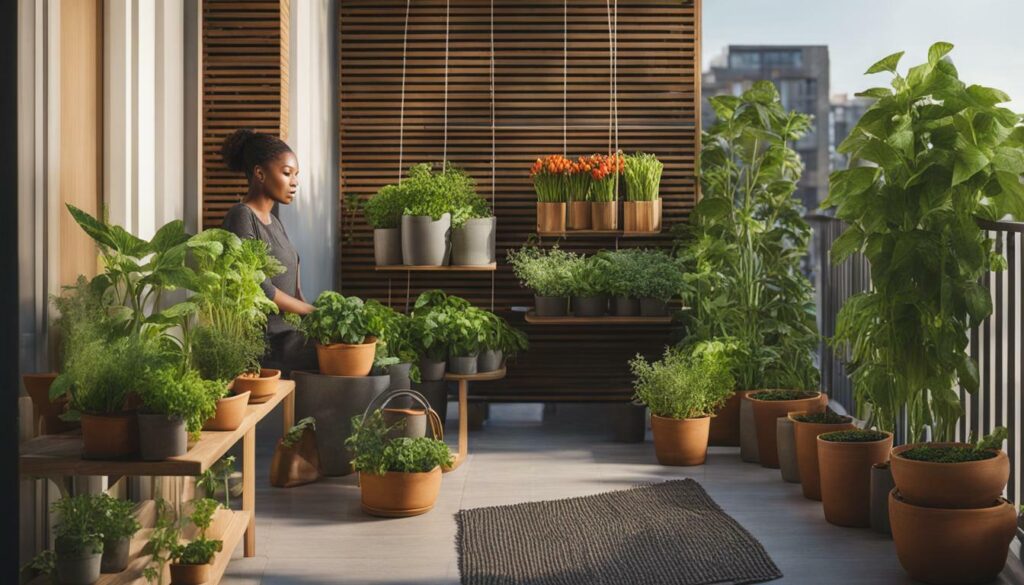
| Plant | Watering | Fertilizing | Pruning | Pest Control |
|---|---|---|---|---|
| Tomatoes | Regularly, deep watering | Every 2-3 weeks with balanced fertilizer | Remove suckers and prune for airflow | Monitor for aphids and tomato hornworms |
| Herbs (e.g., basil, parsley, cilantro) | Keep soil evenly moist | Every 4-6 weeks with organic herb fertilizer | Pinch back for bushier growth | Monitor for herb pests like aphids or whiteflies |
| Lettuce and leafy greens | Regular watering, but avoid overwatering | Every 2-3 weeks with balanced fertilizer | Harvest outer leaves to encourage new growth | Monitor for caterpillars or slugs |
By following these maintenance and care tips, you can ensure that your vertical balcony garden thrives and provides you with a bountiful harvest of fresh and nutritious produce. Enjoy the beauty and productivity of your own small-space garden!
Harvesting and Enjoying the Fruits of Your Labor
Enjoy the satisfaction of harvesting your own homegrown vegetables and herbs from your vertical balcony garden, and discover delicious ways to incorporate them into your meals. Whether you’re picking fresh tomatoes for a Caprese salad or harvesting fragrant basil for homemade pesto, the taste and quality of homegrown produce are unparalleled. Plus, the convenience of having a bountiful supply of herbs and vegetables just steps away from your kitchen is unbeatable.
As you harvest your vegetables and herbs, it’s important to pick them at the right time to ensure optimal flavor and texture. Different plants have different harvest times, so it’s essential to familiarize yourself with the specific requirements of each variety. For example, tomatoes can be picked when they are fully ripe and have vibrant color, while herbs like basil should be harvested before they start flowering to preserve their flavor.
To make the most out of your harvest, try incorporating your homegrown produce into a variety of dishes. From fresh salads and stir-fries to homemade sauces and soups, the possibilities are endless. Experiment with different flavor combinations and let the vibrant colors and flavors of your homegrown vegetables and herbs take center stage.
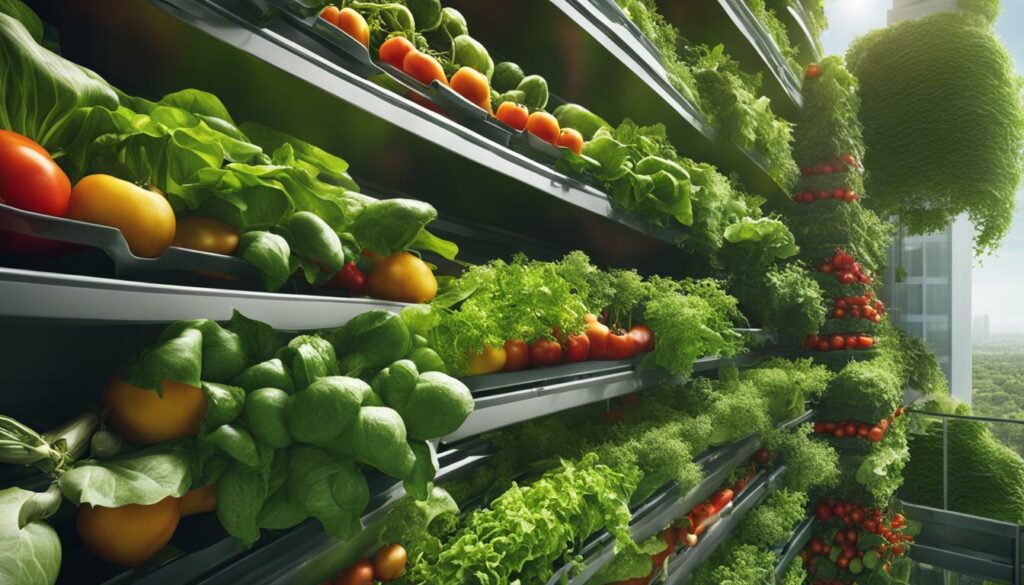
Vertical Balcony Garden Harvesting Tips:
- Follow the specific harvest times for each plant variety to ensure optimal flavor and texture.
- Harvest vegetables when they are fully ripe and have vibrant color.
- Harvest herbs before they start flowering to preserve their flavor.
- Incorporate your homegrown produce into a variety of dishes, from salads and stir-fries to sauces and soups.
- Experiment with different flavor combinations and let the vibrant colors and flavors of your homegrown vegetables and herbs take center stage.
By harvesting and enjoying the fruits of your labor, you can truly experience the rewards of vertical balcony gardening. Not only will you have a source of fresh, nutritious produce, but you’ll also gain a sense of satisfaction and connection to nature as you nurture and harvest your own homegrown vegetables and herbs.
| Vegetable | Harvest Time |
|---|---|
| Tomatoes | When fully ripe and vibrant in color |
| Lettuce | When leaves are young and tender |
| Herbs (such as basil, parsley, and mint) | Before they start flowering |
| Cucumbers | When firm and crisp |
| Peppers | When mature and firm |
Vertical Gardening Success Stories
Discover inspiring stories of individuals who have transformed their balconies into flourishing urban gardens, showcasing the power of vertical gardening in small spaces.
First, we have Sarah, a city dweller with a love for fresh produce. Despite living in a small apartment with only a balcony for outdoor space, Sarah was determined to grow her own vegetables. With a vertical gardening approach, she utilized hanging shoe organizers to create a thriving vegetable garden. Her balcony now boasts an abundance of herbs, lettuce, and even tomatoes. Sarah’s success not only provides her with fresh, organic produce but also serves as a beautiful and functional addition to her outdoor living space.
Next, we have John, who turned his small balcony into a hydroponic garden paradise. With limited soil space, John opted for a hydroponic system that circulates nutrient-rich water through his plants’ roots. His vertical garden not only maximizes space but also allows for higher crop yields and faster growth. John now enjoys a bountiful harvest of fresh herbs, leafy greens, and even strawberries, all grown in the convenience of his urban balcony.
Lastly, we have Emily, who took a creative approach to vertical gardening by repurposing old ladders. By attaching planter boxes to the rungs of the ladder, she created a unique and visually stunning vertical garden. Her balcony is now adorned with an array of colorful flowers and trailing vines, providing a beautiful backdrop for outdoor relaxation. Emily’s vertical garden not only adds beauty but also serves as a conversation starter and source of inspiration for her neighbors.
“Vertical gardening has transformed my balcony into a green oasis. It’s amazing to see what can be achieved in such a small space. I love being able to grow my own food and enjoy the beauty of nature right outside my door.” – Sarah
These success stories highlight the endless possibilities of vertical gardening in small spaces. Whether utilizing hanging shoe organizers, hydroponic systems, or repurposed ladders, individuals are finding innovative ways to maximize their balcony space and create stunning gardens. Vertical gardening not only provides the joy of growing your own food but also adds beauty, promotes relaxation, and fosters a connection with nature.
Vertical Gardening Success Stories
| Success Story | Technique | Results |
|---|---|---|
| Sarah | Hanging Shoe Organizers | Abundance of herbs, lettuce, and tomatoes |
| John | Hydroponic System | Bountiful harvest of herbs, greens, and strawberries |
| Emily | Repurposed Ladders | Colorful flowers and trailing vines |
These success stories serve as inspiration for anyone looking to maximize their balcony space and reap the benefits of vertical gardening. With a little creativity and the right techniques, you too can transform your small outdoor area into a flourishing urban garden.
Conclusion
By implementing these tips and techniques, you can create a thriving vertical balcony vegetable garden and experience the joy of urban gardening in a limited space. With the increasing trend of small space living in urban areas, maximizing your balcony space with a vertical garden is not only practical but also rewarding.
Vertical balcony gardening offers numerous benefits, including the ability to grow a variety of vegetables and herbs even in a small area. You can choose from a range of creative ideas such as using plastic gutters, hanging shoe organizers, and vertical green planters to make the most of your vertical space. These DIY projects are not only space-saving but also visually appealing, adding a touch of greenery and freshness to your balcony.
When choosing plants for your vertical garden, consider factors such as sunlight exposure, plant size, and growth habits. Opt for shade-tolerant plants if your balcony receives limited sunlight, or use a grow light to provide the necessary light for sun-loving vegetables. Proper watering and soil drainage are essential for the health and growth of your plants. If you don’t have access to a water spigot, be creative with watering methods such as using a watering can or exploring hydroponic systems.
Maintaining and caring for your vertical balcony garden is also crucial for its success. Regular watering, pruning, and pest control will ensure the longevity and productivity of your plants. Additionally, you can maximize space in your vertical garden by utilizing creative solutions such as trellises, hanging pots, and repurposed materials. These techniques will not only save space but also add visual interest to your balcony.
Once your vertical balcony vegetable garden is thriving, you can enjoy the fruits of your labor by harvesting homegrown produce. Harvesting at the right time and experimenting with recipes using your fresh vegetables will enhance your culinary experience and provide a sense of satisfaction and accomplishment.
Vertical gardening success stories from individuals who have created thriving vertical balcony gardens serve as inspiration and motivation for others. These stories highlight the creativity, productivity, and positive impact that urban gardening can have on one’s life. With a little time, effort, and creativity, anyone can create a beautiful and productive vertical balcony vegetable garden.
In conclusion, urban gardening offers a unique opportunity to maximize limited space by creating a vertical balcony vegetable garden. By utilizing the tips and ideas discussed in this article, you can transform your balcony into a flourishing oasis of fresh produce and greenery. Whether you are a seasoned gardener or a beginner, vertical gardening is a practical and rewarding way to enjoy the benefits of nature even in the midst of urban living.
Are Vertical Vegetable Gardens a Practical Solution for Small Spaces?
Vertical vegetable garden fences are an excellent solution for small spaces. They allow individuals to grow their own produce without the need for a large yard or garden. These innovative structures make use of vertical space, making them a practical and efficient option for urban dwellers and those with limited space.
FAQ
Q: What are the benefits of vertical balcony gardening?
A: Vertical balcony gardening allows you to maximize space in small urban areas, provides a sense of self-sufficiency, promotes well-being and connection with nature, and results in fresh and flavorful homegrown produce.
Q: How do I get enough sunlight for my vertical balcony garden?
A: If your balcony is covered or gets limited direct sunlight, you can choose shade-tolerant plants, use grow lights to supplement sunlight, or place sun-loving plants on the edge of your balcony to maximize exposure.
Q: How should I water my vertical balcony garden?
A: Depending on access to a water spigot, you can use a hose and timer, carry water with a watering can, or opt for hydroponics with a recirculation system. It’s important to ensure well-draining soil and collect excess water with trays.
Q: How do I choose the right plants for vertical gardening?
A: Consider factors like sunlight exposure, plant size, and growth habits when selecting plants for your vertical balcony garden. Choose shade-tolerant varieties, compact plants, and those that can thrive in containers.
Q: What are some DIY vertical vegetable garden ideas for a balcony?
A: You can use plastic gutters, hanging shoe organizers, vertical green planters, and more to create a vertical vegetable garden on your balcony. Get creative with repurposed materials and maximize space.
Q: How do I maintain and care for a vertical balcony garden?
A: Proper watering, pruning, and pest control methods are essential for maintaining a vertical balcony garden. Regularly check for pests, provide adequate water and nutrients, and keep the garden tidy.
Q: How can I maximize space in a vertical balcony garden?
A: Use trellises, hanging pots, and repurposed materials to maximize space in a vertical balcony garden. Think vertically and make use of vertical surfaces for planting.
Q: How do I harvest and enjoy the produce from my vertical balcony garden?
A: Harvest your homegrown produce at the right time and enjoy it fresh or incorporate it into delicious recipes. Take pride in the fruits of your labor and savor the flavors of your vertical balcony garden.
Q: Are there any success stories of vertical balcony gardening?
A: Many individuals have successfully created thriving vertical balcony gardens, showcasing their creativity, productivity, and the positive impact it has had on their lives. These success stories inspire and encourage others to start their own vertical gardening journey.
Q: How can urban gardening contribute to maximizing limited space?
A: Urban gardening, such as vertical balcony gardening, allows individuals to maximize limited space and create green oases in urban environments. It promotes sustainability, self-sufficiency, and a connection with nature in densely populated areas.

